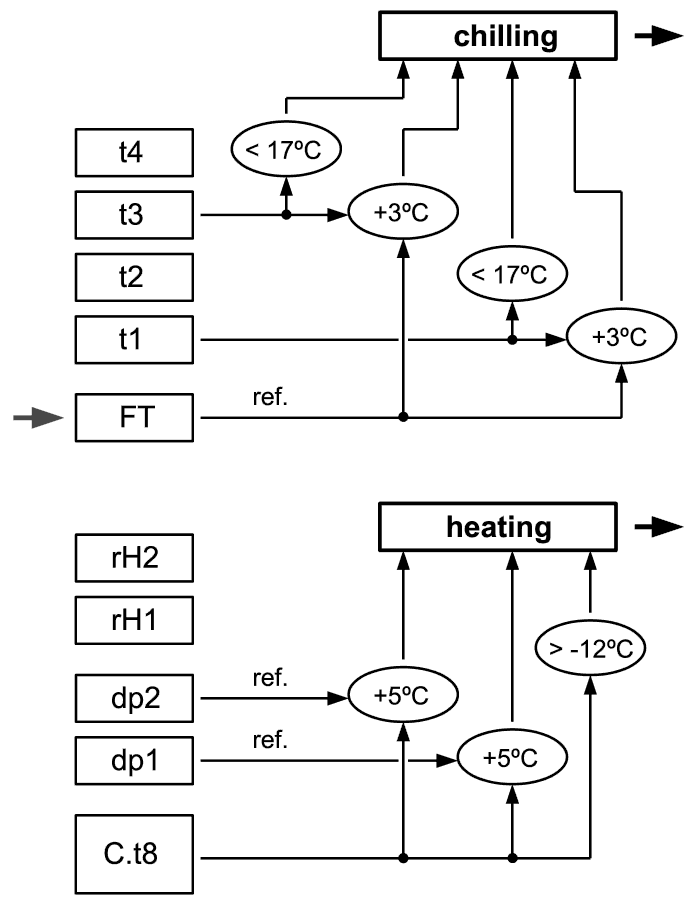Dome air conditioning
Using its two outputs (one that controls heating, the other one cooling), ETH-2 is able to perform basic air conditioning using meteorological data obtained from its inputs. For each of the two channels, operator can define up to four conditions that cause its activation. Each “condition” consists of the chosen measurement channel (temperature, humidity of dew point) and one of its previously defined limits (absolute or relative). If at least one of the four conditions belonging to a particular output channel is satisfied, that output activates.
Please note that both output channels can be active at the same time as they are not necessarily meant to control chilling and heating of air inside the dome. Rather, while chilling is usually applied to the inside air, heating output often serves to turn on primary mirror heating with the aim of preventing dew formation on its reflective surface. In case that chilling and heating should not be active simultaneously, a simple AND-OR type hardware logic is expected to be added by the dome air conditioning system designer to one of the ETH-2 outputs in order to prevent its activation when the other output chanel is on.
Air conditioning setup example
All that has been said up untill now might sound a bit complicated, but this example should help in clarifying things up. Let’s imagine that raw temperature channels
t5 -
t8 are combined into a “
CT8“ composite temperature channel which measures average primary mirror temperature,
t1 and
t3 measure air temperature at two heights inside the dome, while
t2 and
t4 measure temperature of the air outside. Also, let’s imagine that
rH1 measures relative air humidity inside the dome, while
rH2 that of air outside of it. Consequently,
dp1 and
dp2 are calculated dew points for air inside and outside the dome (this setup is schematically depicted in the diagram under the
previous tab). Finally, let’s declare “
FT” the forecasted temperature for the following night.
Problem
Now let’s imagine that the telescope operator wants to control the heat pump so that air temperature inside the dome is:
-
always lower than +17°C, at any height
-
never higher than 3°C with respect to the forecasted air temperature, at any height
In addition, let’s imagine that operator also wants to control the primary mirror heater so that mirror temperature is:
-
never lower than -12°C
-
always more than 5°C higher than any of the two dew points
Solution
The first step in finding the solution is picking key measurement channels and defining their limit thresholds such that they will provide defining adequate actuation conditions for control functions:
-
For the first control output (chilling), the operator sets absolute maximum thresholds for t1 and t3 to +17°C, and also sets relative thresholds for t1 and t3 to 3°C, choosing FT as the reference channel for both of them.
-
For the second output (heating), the operator sets the absolute minimum threshold for CT8 to -12°C, and sets both CT8 relative thresholds to 5°C, choosing dp1 and dp2 as reference channels for these.
After that, the operator sets states of both air conditioning control outputs to “active” and dedicates appropriate conditions to each of them (4 former conditions to the chilling-, and 3 latter conditions to the heating output channel). This is represented schematically in the diagram below:

Complex air conditioning
In addition to this, operator is able to define several more limit conditions, but they will not be taken into account by ETH-2 firmware control functions when deciding whether to activate its two control outputs. Those limits will instead trigger ELM-4 Central controller module
audio and visual alarms (with the help of AS2 Communicator software), and will be able to influence activation of additional AS2 Communicator software control functions that are able to perform
advanced air conditioning of the dome using the additional output hardware, but will not influence the operation of the two ETH-2 control outputs directly.
We remind the reader that
ELM-4 data bus specification and
AS2 Communicator PC application software permit easy integration of up to 15 input-output controllers into the system, each of them with 8 input and 8 output channels that can be used to control various equipment around. Similarly, if a single ETH-2 device per dome is insufficient, up to 15 of them can be connected to the same ELM-4 system.

